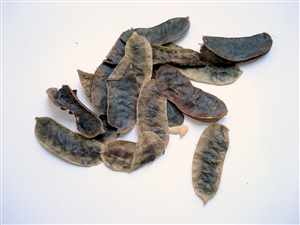Senna (Cassia Acutifulia, Cassia Alexandrina, Cassia Marilandica, Cassia Senna)
Main Facts about Senna

Senna is a woody perennial shrub, up to 6 feet tall with branching stems, pointed leaves, and fragrant yellow flowers followed by pea-like leathery seedpods up to 3 inches long. Parts used – leaves, pods.
Senna is native to Egypt and Sudan and is videly cultivated in India and other warm regions of the world. Arab physicians first wrote of the herb’s bowel-stimulating effects in the 9th century, but it was probably used for centuries before that.
Both Senna and Cinnamon come from trees with peelable bark – in Arabic, “quetsiah”, meaning “to cut.” “Quetsiah” evolved into Senna’s genus name, Cassia. Although both Senna and Cinnamon are sometimes called Cassia today, these two herbs have very different actions and should not be confused.
Now Senna is an ingredient in many commercially prepared, over-the-counter laxatives. It has a very strong effect and is generally recommended for use only when other remedies – such as lifestyle and dietary changes, as well as more gentle laxatives – have not been effective.
Using Senna
The herb contains compounds called anthraquinones, which stimulate the colon. Most modern commercial products are made from the plant’s leaflets or fruits, but some authorities say products made from the seedpods have a more gentle laxative effect than those made from the leaves. When digested, the herb provokes intestinal muscle contractions (peristalsis), thereby speeding the body’s elimination of waste. It’s often taken with carminative (gas-dispelling) herbs, such as Ginger, Thyme, or Caraway, both to reduce intestinal cramping and to mask Senna’s bitter and unpleasant – even nauseating – taste. This plant has been well studied in clinical settings.
Habitual use may lead to “lazy bowel syndrome”, in which the colon becomes unable to function without the laxative.
The compounds responsible for laxative action develop upon drying and are not found in the fresh herb.
Senna is a remedy for: Constipation
Cooking with Senna

How to grow Senna
The species generally used in herbal medicine is grown in the Tennevelly region of India, near the subcontinent’s southern tip. One species grows in the eastern United States.
American Senna (Senna marilandica) grows in moist but well-drained soil in full sun. It is recommended that the seeds are scarified to help break the coating before planting. To do this place seeds on a coarse sheet of sandpaper and then rub over with a second sheet. This helps to break the coating allowing water to penetrate more easily and enhance germination. Seeds can also be soaked for several hours before seeding. Plant seeds in cell pots or several to an individual pot. Due to the hard coat seeds can take anywhere from 1 to 12 weeks to germinate. Plant outside in spring, when temperatures have warmed. Harvest the leaves in summer and the pods in fall. Propagate the herb from seed or take cuttings in early summer.
| Saw Palmetto |
Shiitake
|